Gigabit Ethernet
-
- The Quest to Find and Explore USS Indianapolis Marine Technology, Oct 2017 #20
Sunk by Japanese torpedoes near the end of World War II, heavy cruiser USS Indianapolis disappeared to the darkest depths of the Philippine Sea, where it remained undiscovered for more than 70 years. Recently a team of civilian researchers led by Microsoft co-founder Paul G. Allen set out equipped with an arsenal of high-tech search equipment on a mission to locate the historic vessel last seen on July 30, 1945.
The story of the USS Indianapolis is one of military might, heroism, tragedy, controversy and mystery. Built by New York Shipbuilding Corporation in Camden, N.J., the 623-ft., 9,800-ton Portland Class heavy cruiser USS Indianapolis (CA-35) entered service in November 1932, serving through campaigns that earned the ship 10 battle stars over the course of World War II.But after much success in battle, the fate of the Indianapolis eventually turned tragic as World War II neared its end. In the early hours of July 30, 1945, having just completed a secret mission to deliver materials from California for the first operational atomic bomb, “Little Boy” to a naval base on the Pacific island Tinian, Indianapolis was en route from Guam to Leyte when it was torpedoed by Japanese submarine I-58.Indianapolis sank quickly – reportedly in just 12 minutes – leaving little time for the crew to deploy lifeboats or for an emergency signal to be sent. It is estimated that 800 of the nearly 1,200 Sailors and Marines on board survived the sinking, but a communication error prevented Navy command from having any knowledge of the sinking, and rescuers were not immediately dispatched. This left survivors to battle exposure, dehydration, drowning and shark attacks for a grueling four to five days at sea until help finally arrived. In the end, only 316 were rescued in what remains the largest loss of life at sea in U.S. naval history.Due to the ship’s rapid sinking and lack of a distress call, the ship’s location had long remained a mystery – until recently.Microsoft co-founder, philanthropist and entrepreneur Paul G. Allen is fascinated with World War II history. Combining this passion with a spirit of technological innovation, Mr. Allen and his Seattle-based company Vulcan Inc. set out to hunt for the Indianapolis. The team embarked with several high-profile marine archaeology projects already under their belt, including the discovery of Japanese battleship Musashi in March 2015 and Italian WWII destroyer Artigliere in March 2017, as well as the recovery of the bell from the HMS Hood for presentation to the British Navy.Other search missions to locate Indianapolis have been undertaken by various groups over the years, but all have come up short – partly due to a lack of sufficient technology. For the Indianapolis search, Mr. Allen deployed an exploration team outfitted with the latest state-of-the-art deep search and exploration equipment aboard the newly acquired 76-meter-long DP2 vessel RV Petrel. Vulcan Inc. purchased the offshore service vessel in 2016 from subsea engineering, construction and services company Subsea 7. The ship was converted into a bonafide deep submergence research vessel in 2017, and now sails as one of the select few ships worldwide equipped to explore 6,000 meters below the ocean’s surface.For the Indianapolis search, the Vulcan team conducted a significant amount of research, leveraging a combination of historical records, detailed undersea topographical data and advanced technology to explore a 400 square nautical mile search area between Guam and Palau in the Philippine Sea. A key data point came from a discovery by Dr. Richard Hulver, a historian with the Naval History and Heritage Command, who identified a naval landing craft that had recorded sighting the USS Indianapolis hours before it was torpedoed. All this research led to a new estimated position west of where previous searches have been conducted.But even with the new insight, finding a ship that has been missing for over seven decades is no easy task, especially at depths greater than 5,000 meters. Aiding Vulcan’s team is a 6,000-meter-rated autonomous underwater vehicle (AUV), the REMUS 6000, manufactured by Kongsberg Maritime subsidiary Hydroid Inc., which gathered sonar data to locate the USS Indianapolis.Used regularly in commercial, research and defense applications, the REMUS 6000 AUV has been labeled a “deep-water workhorse” by Hydroid. The vehicle can be configured to include a wide variety of payloads to meet diverse mission requirements and is capable of navigating for 20-22 hours of high speed search operations during a single dive, providing efficient coverage of wide areas. “Outfitted with a payload equipped with the tools to optimize the wreckage search, the REMUS 6000 vehicle was an ideal, versatile solution for this mission. This is one of the many reasons why the vehicle is in a league of its own; we are able to design it to meet individual operational requirements,” a Hydroid representative said. “The REMUS 6000 has proven time and time again that it is a reliable, field-proven solution. Specifically, it was used in the discovery of Air France Flight 447, a passenger flight that crashed in June 2009, and to explore the site of the Titanic sinking in July 2010.”To find the long-lost Indianapolis, the REMUS 6000 AUV was equipped with long range, high resolution side scan sonar and bathymetry equipment for scanning the seafloor to detect and classify anomalies. The EdgeTech dual frequency 2205 75kHz / 230kHz side scan with interferometric bathymetry was mounted on the AUV to acoustically image a large 1 km range (in low frequency mode) from each side of the vehicle while flying preprogrammed deepwater searches in a mowing pattern.Once a search grid was completed, the AUV surfaced at a preset location for retrieval to the Petrel. On board the team downloaded stored survey data for review and swapped batteries for redeployment. Data analysis revealed seabed anomalies such as geology features or manmade objects/debris that could potentially point out the location of the missing warship. Once targets of interest were identified and mapped at closer range and higher resolution at 230 kHz, the Petrel team deployed a newly built, class-leading remotely operated vehicle (ROV) system for positive identification.For design, build and commissioning of the specialty ROV, Mr. Allen’s team contracted 3U Technologies LLC to manage overall system design and integration. Vulcan had initially contracted 3U in 2012 to investigate 6,000-meter rated ROV solutions to extend its exploration and archeology capabilities to a majority of the world’s ocean depths. 3U worked under the direction of Robert Kraft, Vulcan’s Director of Subsea Operations, to engineer what Mr. Kraft called “arguably one of the most technologically advanced and capable deep diving ROV systems in the world today.”“Vulcan’s project team consists of experienced diving systems professionals and was expressly determined to push the boundaries and capabilities in the deep submergence realm,” said Carl Barrett, 3U Project Manager. “The goal was to extend the present industry state-of-the-art to a full 6,000 meter depth capability.”3U and Vulcan sourced, specified and designed all key systems/subsystems and managed equipment manufacturing, testing and integration from a worldwide supplier base. The result, Mr. Barrett said, is a powerful 100 kW ROV system (90 kW at ROV) which is well outfitted for deep ocean exploration. Key features include:- An integrated surface control and data management suite with intuitive interfaces;
- Dual interchangeable pilot and navigation control stations with ergonomic Cyber chairs;
- INS and DVL Based Automation: Waypoint navigation and station keeping; sonar target tracking and station keeping;
- Powerful all-electric propulsion with 550 kg horizontal and 780 kg vertical thrust capacity;
- 4500 VAC, 17mm diameter umbilical;
- 5 kW LED lighting system;
- Broadcast quality HDTV video cameras;
- Scanning and multi-beam sonar systems;
- Fiber optic MUX featuring multiple high bandwidth data channels: Gigabit Ethernet; Serial Data;
- Dual Titan 4 manipulators: Isolated hydraulic supply; and
- 18 kW tooling hydraulic system: Operator adjustable flow and pressure
Mr. Barrett explained that the Petrel ROV serves primarily as a camera and survey sensor platform that must maintain a no-touch policy out of respect for the hallowed wreck sites it typically explores. “The vehicle system must provide a stable platform with excellent station keeping capabilities for close proximity video work, have a powerful propulsion system to combat currents impacting both the ROV and the entire 6,000 meter umbilical length, provide the operators with outstanding situational awareness and operate reliably and efficiently for extended durations,” he said.Also instrumental to the mission was the OPENSEA operating platform from Greensea, which “provided a stable, automated operating platform for acquisition of stunning video sequences, created operational efficiencies which minimized operator task loading and dramatically simplified integration of a large suite of camera and sensor packages into a coherent and intuitive operator interface,” Mr. Barrett said. “Greensea’s data management and archival system provides ease of access to a wealth of data (past and present) such that operators can maintain situational awareness and monitor vehicle health with minimum effort to maintain focus on mission goals.”Synchronized pilot and co-pilot chairs allowed vehicle control and navigation to be switched between pilots, complete with touchscreen displays to support simultaneous operation of lights, cameras, positioning and hydraulics. The system even included an automated ascent and descent for the umbilical winch that enabled pilots to automatically synchronize ROV depths.“Greensea’s OPENSEA control system is crucial to our success for extreme deep diving operations. Never before have I experienced an ROV control environment as unified, configurable or integrated as this one,” Mr. Kraft said.With help from some of the most capable and advanced equipment available, the Vulcan team located the wreckage of the USS Indianapolis on August 19, resting 5,500 meters below the surface in the Philippine Sea where it will remain undisturbed as a naval war grave. The wreck’s exact location was provided to the U.S. Navy exclusively, as the wreck is property of the U.S. Navy.“To be able to honor the brave men of the USS Indianapolis and their families through the discovery of a ship that played such a significant role during World War II is truly humbling,” Mr. Allen said in a press release announcing the discovery. “As Americans, we all owe a debt of gratitude to the crew for their courage, persistence and sacrifice in the face of horrendous circumstances. While our search for the rest of the wreckage will continue, I hope everyone connected to this historic ship will feel some measure of closure at this discovery so long in coming.”AcknowledgementsSpecial thanks to Carl Barrett and the team at 3U Technologies, LLC.(As published in the October 2017 edition of Marine Technology Reporter) -
- Adventure Under Ice Marine Technology, Mar 2015 #50
hair. The tether carries high-definition video and navigational data back and forth to the mother ship at the speed of light. This cable provides a gigabit Ethernet data stream to the surface, as well as a high-definition video feed that will allow scientists to observe the under-ice world as never before
-
- MTR100: Teledyne Oil & Gas (PART II) Marine Technology, Aug 2015 #42
Electrical Connectors, Electrical Penetrator Assemblies, Magnetically Operated Proximity Switch and Custom Molded Products. Recent advances in Gigabit Ethernet interconnect solutions for instrument data transmission are enabling more data and faster transmission times. ODI is a leader in subsea electrical
-
 )
September 2023 - Marine Technology Reporter page: 76
)
September 2023 - Marine Technology Reporter page: 76designed to simplify integration for underwater asset monitoring. At the SAAB SEAEYE heart of the system is Alpheus, a ? ber www.saabseaeye.com optic gigabit smart ethernet hub and For more than 35 years, Saab Seaeye multiplexer telemetry system. technology has led the industry with in- • The Mako Autonomous
-
 )
September 2023 - Marine Technology Reporter page: 14
)
September 2023 - Marine Technology Reporter page: 14breakthrough connectivity capabilities in sev- scienti? c survey missions. Dubbed Shackleford, it is a eral areas: electrical, RF, optical and hybrid. Gigabit Speed 73- by 26.7-ft. semi-displacement aluminum catamaran Data Transfer Capabilities: BIRNS developed exclusive developed by Nic de Waal of Teknicraft
-
 )
September 2023 - Marine Technology Reporter page: 12
)
September 2023 - Marine Technology Reporter page: 12MTR 100 over Active Fluorescence (STAF) instruments, Chelsea is now at the forefront of practical measurements of phytoplankton photosynthesis, helping scientists understand the part that the oceans play in climate change as we look to achieve Net Zero. • Formed in 1978, EIVA provides software, equipment
-
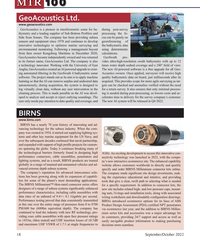 )
September 2022 - Marine Technology Reporter page: 18
)
September 2022 - Marine Technology Reporter page: 18characteristics, including cable assemblies with ing nuts, O-rings and installation tools, along with associated data rates of an unheard of 9.4+/- 0.1 Gigabits per second. wiring worksheets and downloadable con? guration drawings. Performance testing proved that data consistently transmitted BIRNs introduced
-
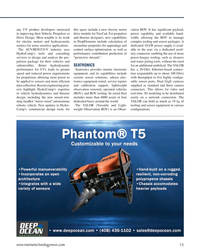 )
September 2022 - Marine Technology Reporter page: 15
)
September 2022 - Marine Technology Reporter page: 15any UV product developers interested this space include a new electric motor vation ROV. It has signi? cant payload, in improving their Vehicle, Propulsor or drive module for NavCad. For propulsor power capability and available band- Drive Design. Most notable is its work and thruster designers
-
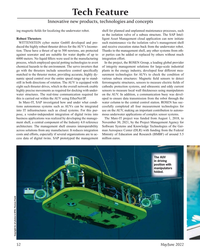 )
May 2022 - Marine Technology Reporter page: 52
)
May 2022 - Marine Technology Reporter page: 52Tech Feature Innovative new products, technologies and concepts ing magnetic ? elds for localizing the underwater robot. shell for planned and unplanned maintenance processes, such as the isolation valve of a subsea structure. The SAP Intel- Robust Thrusters ligent Asset Management cloud application can
-
 )
September 2020 - Marine Technology Reporter page: 59
)
September 2020 - Marine Technology Reporter page: 59New South African Navy Survey Boat Paramount Maritime, a Paramount which having taken place within South Group company, said it has launched Africa. The 11m length overall (LOA) the ? rst of three next-generation Survey Survey Motor Boat hosts two twin Volvo Motor Boats (SMBs) to the South African
-
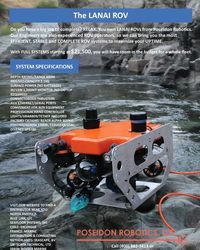 )
September 2020 - Marine Technology Reporter page: 13
)
September 2020 - Marine Technology Reporter page: 13The LANAI ROV Do you have a big job to complete? RELAX. You own LANAI ROVs from Poseidon RoboO cs. Our Engineers are also experienced ROV operators, so we can bring you the most EFFICIENT, STABLE and COMPLETE ROV systems to maximize your UPTIME. , With FULL SYSTEMS starO ng at you will have room in
-
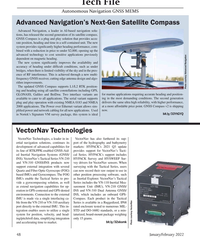 )
January 2022 - Marine Technology Reporter page: 48
)
January 2022 - Marine Technology Reporter page: 48Tech File Autonomous Navigation GNSS MEMS Advanced Navigation’s Next-Gen Satellite Compass Advanced Navigation, a leader in AI-based navigation solu- tions, has released the second generation of its satellite compass. GNSS Compass is a plug and play solution that provides accu- rate position, heading and
-
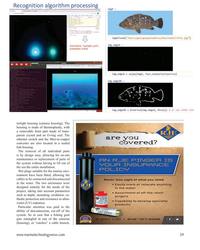 )
November 2021 - Marine Technology Reporter page: 39
)
November 2021 - Marine Technology Reporter page: 39tertight housing (camera housing). The housing is made of thermoplastic, with a removable front part made of trans- parent crystal and an O-ring seal. The ethernet switch and the ? ber-to-copper converter are also located in a sealed hub housing. The removal of all individual parts is by design easy
-
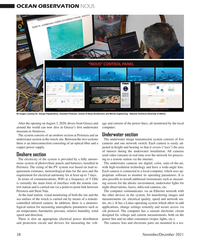 )
November 2021 - Marine Technology Reporter page: 38
)
November 2021 - Marine Technology Reporter page: 38OCEAN OBSERVATION NOUS All images courtesy Dr. George Papalambrou, Assistant Professor, School of Naval Architecture and Marine Engineering, National Technical University of Athens After the opening on August 3, 2020, divers from Greece and age and current of the power lines, all monitored by the local
-
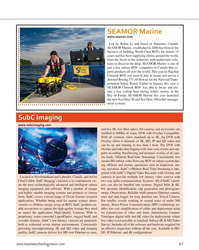 )
September 2021 - Marine Technology Reporter page: 67
)
September 2021 - Marine Technology Reporter page: 67SEAMOR Marine www.seamor.com Led by Robin Li and based in Nanaimo, Canada, SEAMOR Marine, established in 2006 has been in the business of building World Class ROVs for almost 15 years and has been supplying clients around the world, from the Arctic to the Antarctic, with underwater solu- tions to
-
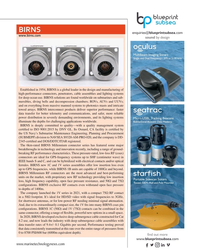 )
September 2021 - Marine Technology Reporter page: 25
)
September 2021 - Marine Technology Reporter page: 25submergence cable constructed for Cat 8.2 use, and now leads the industry with deep submergence cable assemblies with data transfer rates of 9.4+/- 0.1 Gigabits per second. Performance testing proved that data consistently transmitted at this rate over the entire range of pressures from 0 to 8700 PSI/600
-
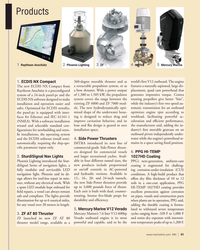 )
March 2021 - Marine News page: 41
)
March 2021 - Marine News page: 41Products 1 2 3 4 5 Raytheon Anschütz Phoenix Lighting ZF IMTRA Mercury Marine 360-degree steerable thruster and as world’s ? rst V12 outboard. The engine 1. ECDIS NX Compact The new ECDIS NX Compact from a retractable propulsion system, or as features a naturally aspirated, large
-
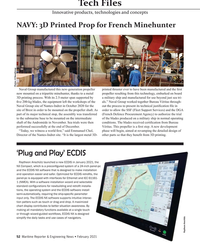 )
February 2021 - Maritime Reporter and Engineering News page: 52
)
February 2021 - Maritime Reporter and Engineering News page: 52Tech Files Innovative products, technologies and concepts NAVY: 3D Printed Prop for French Minehunter Photos: @ NavalGroup Naval Group manufactured this new-generation propeller printed thruster ever to have been manufactured and the ? rst now mounted on a tripartite minehunter, thanks to a metal
-
 )
February 2021 - Maritime Reporter and Engineering News page: 48
)
February 2021 - Maritime Reporter and Engineering News page: 48TECH FILES HEAVY LIFTERS • New trolley cable chain (or festoon) sel-electric power supply, is the most expensive but also • New operator control devices (e.g. change analogue joy- the most environmentally friendly option. The high cost sticks to digital) is due to the mechanical and electrical alterations
-
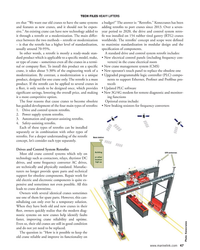 )
February 2021 - Maritime Reporter and Engineering News page: 47
)
February 2021 - Maritime Reporter and Engineering News page: 47TECH FILES HEAVY LIFTERS ers that “We want our old cranes to have the same systems a budget?” The answer is: “Retro? ts.” Konecranes has been and features as new cranes, and it should not be expen- adding retro? ts to port cranes since 2013. Over a seven- sive.” An existing crane can have new technology
-
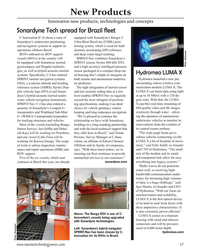 )
November 2020 - Marine Technology Reporter page: 57
)
November 2020 - Marine Technology Reporter page: 57New Products Innovative new products, technologies and concepts Sonardyne Tech spread for Brazil ? eet C-Innovation (C-I) chose a suite of equipped with Sonardyne’s Ranger 2 Sonardyne’s underwater positioning Ultra-Short BaseLine (USBL) posi- and navigation systems to support its tioning system, which
-
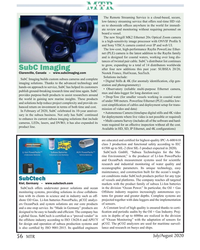 )
July 2020 - Marine Technology Reporter page: 56
)
July 2020 - Marine Technology Reporter page: 56100 MTRMTR The Remote Streaming Service is a cloud-based, secure, low-latency streaming service that offers real-time HD vid- eo to shoreside of? ces anywhere in the world for immedi- ate review and monitoring without requiring personnel on board a vessel. The new Sixgill MK2 Ethernet 20x Optical Zoom
-
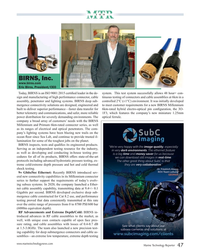 )
July 2020 - Marine Technology Reporter page: 47
)
July 2020 - Marine Technology Reporter page: 47requirements of today’s evolv- ing subsea systems. In 2020, the company launched a Ether- net cable assembly capability, transmitting data at 9.4+/- 0.1 Gigabits per second. BIRNS developed exclusive deep sub- mergence cable constructed for Cat 8.2 use, and performance testing proved that data consistently
-
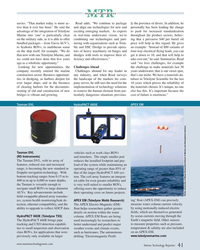 )
July 2020 - Marine Technology Reporter page: 41
)
July 2020 - Marine Technology Reporter page: 41ocean inf uencersl MTRMTR navies. “That market today is more ac- Read adds, “We continue to package ly the province of divers. In addition, he tive than it ever has been.” He said the and align our technologies for new and personally has been leading the charge advantage of the integration of Teledyne
-
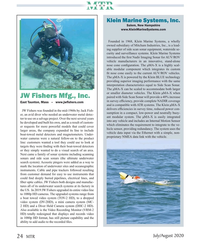 )
July 2020 - Marine Technology Reporter page: 24
)
July 2020 - Marine Technology Reporter page: 24100 MTRMTR Klein Marine Systems, Inc. Salem, New Hampshire www.KleinMarineSystems.com Founded in 1968, Klein Marine Systems, a wholly owned subsidiary of Mitcham Industries, Inc., is a lead- ing supplier of side scan sonar equipment, waterside se- curity and surveillance systems. Klein Marine Systems
-
 )
June 2020 - Marine News page: 58
)
June 2020 - Marine News page: 58PRODUCTS AgilePlans CaaS Autohydro AgilePlans Connectivity as a Service Autoship Sys- (CaaS) from KVH Industries, Inc. tems Corpora- is now available as a subscription- tion updated its based regional offering using KVH’s hydrostatics and stability software, ultra-compact, 37 cm TracPhone
-
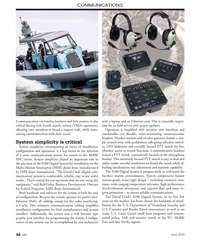 )
June 2020 - Marine News page: 36
)
June 2020 - Marine News page: 36COMMUNICATIONS Communication via wireless headsets and belt stations is also with a laptop and an Ethernet cord. This is especially impor- critical during visit, board, search, seizure (VBSS) operations, tant for in-?eld service and system updates. allowing crew members to board a suspect craft, while
